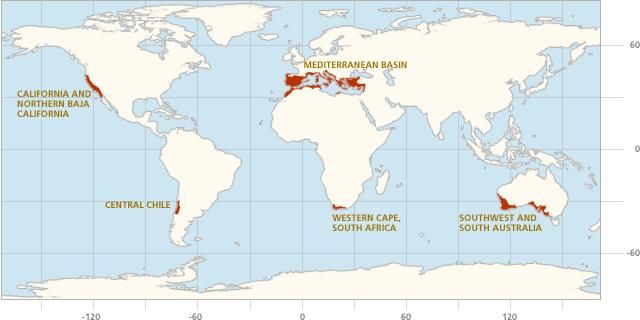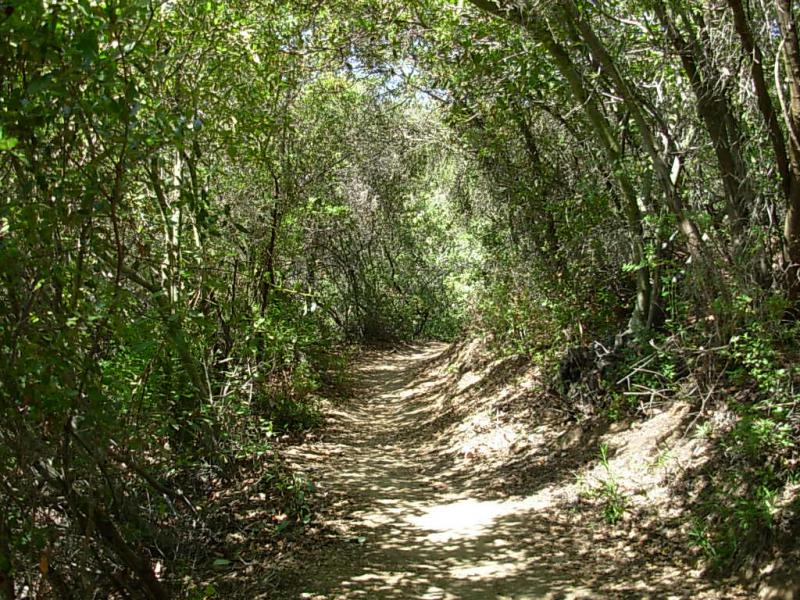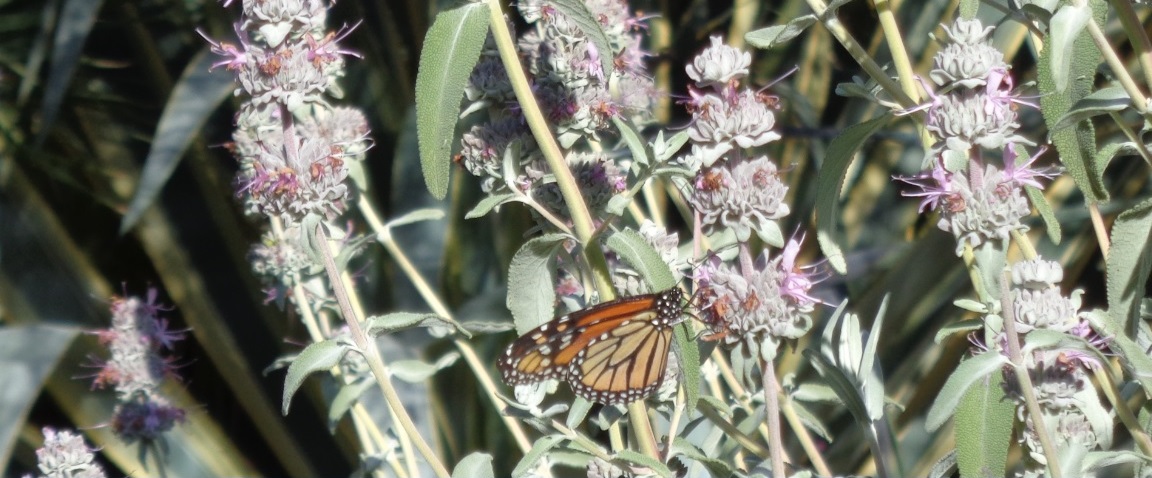Mountains, Development & Restoration
TABLE OF CONTENTS:
- WE LIVE IN A RARE MEDITERRANEAN CLIMATE THAT MUST BE PRESERVED
- Santa Monica Mountains National Recreation Area (SMMNRA) LAND ACQUISITION Problems, Successes & Needs
WE LIVE IN A RARE MEDITERRANEAN CLIMATE THAT MUST BE PRESERVED

Reddish spots are only places with Mediterranean climate
This takes up only 3% of world land mass but it is 16% of the world's plants species.
Source: US National Park Service California Mediterranean Research Learning Center
OUR RARE MEDITERRANEAN CLIMATE IS FULL OF DIVERSITY
This small corner of the world has global significance as a hot spot for biodiversity. We share our Mediterranean climate with only three percent of the world's landmass. In contrast to their small size, Mediterranean ecosystems account for sixteen percent of the world's plant species. As desirable places to live, they are also among the world's most altered areas. Around the globe, Mediterranean ecosystems occur only in two narrow bands, located above and below the equator, between 30 and 40 degrees latitude. Hot, dry summers, alternating with cool, wet winters characterize these regions. The Mediterranean climate, which we know today, was established about 2,000 years ago creating an ecosystem now divided into 11 distinct vegetation communities. Each of these communities supports its own characteristic plant and wildlife populations. This cornucopia of life in the Santa Monica Mountains includes 1000 plant species and over 500 animal species including: birds; coyotes; cats including mountain lions, bobcats and ring-tailed cat; mule deer; small mammals such as the grey fox, rabbits, skunks, raccoons, squirrels, weasels, badgers, bats and rodents; reptiles; amphibians; insects and fish.
Santa Monica Mountains National Recreation Area (SMMNRA) LAND ACQUISITION Problems, Successes & Needs

GREATER SANTA MONICA MOUNTAINS ACQUISITON PLANS SO FAR NOT REALIZED.

(LVHO-Las Virgenes Homeowners Federation CNPS-Calif. Native Plant Society)
Here is a map of the SMMNRA. Map of the entire Santa Monica Mountains National Recreation Area. (It might come on your computer as a PDF symbol-click on it.) This is the National Park Service's (NPS) web map of the SMMNRA. They advertise the SMMNRA as one of the "World's largest urban national parks." When first looking at the map of the SMMNRA you are very impressed by how much land it covers but then you see some puzzling things in the map. The legend says the dark green areas are national parks and the yellow areas are mostly state parks. Then a question pops up in the viewer's mind. What are all those large white spaces in-between the green & yellow areas? The answer given on the map is very vague: "other land within the authorized park boundary." The real answer is that it is mostly private property. LVHO says that there is a 153,705 acre outer protection boundary but inside the boundary is a swiss cheese patchwork of national, state, county and city parks and private property. LVHO goes on to say that private property accounts for about 70,000 acres and it is zoned for private development. The National Park Service owns about 23,000 acres, state parks 35,000 acres, mostly Topanga (10,000acres, Malibu Creek (6400acres, Leo Carrillo (2100 acres) & Point Mugu State Park (15,000 acres.) The land that remains belongs to L.A. City & County, Calabasas City & UCLA.
The original intention was not to have so much private property in-between all those government owned properties. According to Calif. Native Plant Society (CNPS) "The Santa Monica Mountains in the Los Angeles area are remarkable for many reasons, not the least of which is that they are the only mountain range in the country to bisect a great city. Ten miles across at its widest point, fifty miles long, from Point Mugu to Griffith Park, this range lies within an hour's drive of more than six million people. In its many canyons and ridges it preserves thousands of acres of wildness in the midst of the urban area. To protect the best of this magnificent natural area, Congress in 1978 authorized creation of the Santa Monica Mountains National Recreation Area (SMMNRA), under which a 70,000 acre park, to be managed by the National Park Service, was to have been acquired by the mid-1980's and added to the 33,000 acres of existing park land.
National Park Service was slow to fill the inside of the SMMNRA Outer Protection Boundary with land from the Land and Water Conservation Fund Money.
(LVHO) The legislation authorized creation of a 153,705-acre outer protection boundary that took in most of the Mountains west of the 405 freeway to Point Mugu, along with Cheseboro and Palo Comado Canyons north of the 101 freeway. But in 1978 almost none of the land within the outer protection boundary of the new park belonged to the Federal Government; it was private property subject to whatever zoning and development plans its owners and the local authorities were willing to allow - and that was usually quite a bit. While most of our great national parks were created out of lands already owned by the Federal Government, the SMMNRA has had to be purchased one piece at a time from private owners - many of them developers - who had become used to looking on their land as a business investment and a source of personal profit. The money to buy the land that would become this "Great Park" in the Santa Monica Mountains would have to be assembled from scratch out of whatever funds Congress could be persuaded to appropriate each year from the Land and Water Conservation Fund - a special fund financed by revenue from consumptive uses (mining, grazing, oil drilling, etc.) on federal lands. Public Law 95-625 had authorized the Secretary of the Interior to spend a total of $155 million from the Land and Water Conservation Fund to purchase land for the SMMNRA, but each annual appropriation first had to be approved by Congress in that year's federal budget and the Santa Monica Mountains had to compete for that money with supporters of many other parks and other federal projects throughout the country that lobbied each year for the limited budget allocation.
Since 1990 no federal purchases but there were state purchases.
(LVHO) Since the 1990's Congress has appropriated no new federal money to purchase new Park Service lands for the SMMNRA. The major park purchases in the last fifteen years (Ahmanson Ranch, King-Gillette) have been made with State bond money rather than Federal Land and Water Conservation funds. With the State in a budget crisis, state funds have now also dried up, limiting the ability of both State and Federal park agencies to save additional land and complete the Land Protection Plan for the SMMNRA.
Future of the private property within the SMMNRA
Much of the private property within the national recreation area boundary is undeveloped and looks much like the government owned parks but there is a difference. Many of these private holdings were bought with the idea of subdividing them and developing them at some later time. (LVHO) "Aware of that, the County and the Coastal Commission adopted zoning codes and coastal development plans that recognized those owners' constitutional rights to grade and develop privately-owned properties. The Supreme Court will not permit us to deny the owners of these "Swiss cheese" inholdings the right to develop something on their private property under the prevailing zoning." If there isn't enough money to buy this private property than we will be seeing more ugly ridge-top mansions and tract developments when we take a walk in the wilds.
CNPS says, "Unfortunately, acquisition of land for the National Recreation Area has been hamstrung by federal and state budget constraints. The park barely survived a de-authorization attempt in 1981. Meanwhile, growing development pressures and rising land values have frustrated the acquisition of many key parcels. Land use controls, which were supposed to protect park water-sheds and other privately owned areas from incompatible development, have been weakened or withdrawn, especially in Los Angeles County, which contains the great majority of existing and potential parkland. To date less than a fourth of the proposed park has been purchased, and nearly 3/4 of the authorized money has been spent."
The organization Save Open Space mentions that they achieved some of their successes by putting pressure on officials to uphold laws that do exist. They say the following:
Litigation Goals & Observing The Laws
Save Open Space, Santa Monica Mountains is a nonprofit organization that concentrates on maintaining open space, protecting wildlife, and preserving natural resources. SOS protects our open space by holding the permit and planning agencies to existing planning laws. We believe that if existing planning laws are upheld, there will be less destruction of the environment. The primary geographical focus of SOS is the Santa Monica Mountains National Recreational Area and its zone. The specific purposes for which this organization is organized include:
- Educating area residents and local, state, and federal elected officials on the value of preserving open spac
- Informing area residents and necessary officials about development proposals that exceed current zoning and general plan requirements and guidelines.
- Setting up tax deductible accounts for litigation against developments which violate planning laws.
- Making elected officials accountable for upholding general plans and zoning ordinances.
- Endorsing those nonpartisan candidates or elected officials who support the goals of this organization and informing the public of the reason for such political endorsements.
IMPORTANT NAMES INVOLVED IN THE SMMNRA
Development interests had blocked the formation of the SMMNRA for years but its creation happened during President Jimmy Carter's term when on November 10, 1978, he signed Public Law 95-625. The attempted de-authorization was tried by Reagan's Secretary of the Interior, James Watt in 1981 but he did not succeed. Regarding the creation of the SMMNRA, there were certain individuals that were especially important in getting this area classified as a "Recreation Area."
Santa Monica Mountains Park activists Sue Nelson, Jill Swift & Margot Feuer all worked with the Sierra Club.
Did You Know?
Three women, Sue Nelson, Jill Swift, and Margo Feuer galvanized the movement that helped make Santa Monica Mountains National Recreation Area a reality in 1978, per National Park Service
Some people refer to Anthony Beilensen as the father of the SMMNRA and it is true he had political power to work with but there were 3 mothers who worked just as hard and they were Margot Feuer, Sue Nelson & Jill Swift. Both Margot and Sue spent a lot of their time trying to persuade political people to get involved with legislation to provide more land to SMMNRA; Margo became the Sierra Club's principal lobbyist for the park and made repeated trips to Washington to testify before Congress. Jill spent her time getting the public interested in the project by taking people hiking in the mountains for the purpose of showing them what could be lost with development. In 1971 she led 5000 people on a march on Mulholland Drive. She was a member of the Sierra Club task force. Margot was a founder of the group Save Open Space and helped to save Ahmanson Ranch and neighboring Jordan Ranch. Sue was president of the Friends of the Santa Monica Mountains, Parks and Seashore & on the Central Committee of the Sierra Club. Not only did Sue do lobbying for the parks but she, also, was involved in inventorying both plants and wildlife species for the National Park Service. Our Sierra Club cartoonist Willis Simms thought that it was important to keep the Santa Monica Mountains in a natural condition for future generations to enjoy and he felt Anthony Beilenson was the person to do that job. He drew a cartoon to be used to help re-elect Beilenson, which you can see here.
Congressman Brad Sherman is trying to fill the shoes of Tony Beilenson. LVHO says, "Sherman has persuaded the Obama Administration to include $2.4 million in the Fiscal Year 2013 Budget to enable the Park Service to acquire and protect an additional 238 acres of land, mostly "Swiss Cheese" private inholdings in rugged, scenic Zuma and Trancas Canyons off Kanan Dume Road, but Sherman's office indicated some of the $2.4 million could be used to purchase very scenic wilderness land on the north slope of Castro Peak just west of Malibu Lake. But it's going to be up to a particularly contentious, unpopular Congress to decide whether the $2.4 million in President Obama's Draft 2013 Budget becomes available to the National Park Service to buy up to 238 acres of rugged, scenic Zuma Canyon or whether, once again, Congress will "zero out" the Santa Monica Mountains' land acquisition budget and leave almost 70,000 acres of potential parkland waiting for the bulldozers.
If you want to read more about the history of the creation and ongoing issues concerning the SMMNRA here are 2 links to articles below that can help you. July 12, 2012 article by Las Virgenes Homeowners Federation:The Battle for Santa Monica Mountains Goes On.
Our Mediterranean climate makes up only 3% of world land mass but it is 16% of the world's plants species.
Source: US National Park Service California Mediterranean Research Learning Center
These plants on private land could be lost to development in the Santa Monica Mountains National Recreation Area


